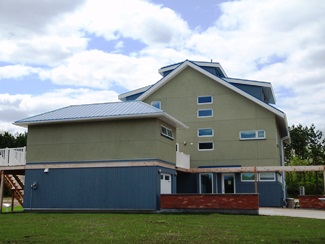External Walls
 External walls of a building are a combination of walls and windows. Wall panels have good insulation properties, while windows are poor insulators, but allow natural daylight and views. A successful design strategy should determine the best ratio of window area to wall area and the proper placement of windows, taking into consideration façade orientation, solar and thermal characteristics, and prevailing wind directions.
External walls of a building are a combination of walls and windows. Wall panels have good insulation properties, while windows are poor insulators, but allow natural daylight and views. A successful design strategy should determine the best ratio of window area to wall area and the proper placement of windows, taking into consideration façade orientation, solar and thermal characteristics, and prevailing wind directions.
Air leakage is a major concern in buildings. Cold air can enter a building through leaks and gaps in the building envelope, introduced by the negative indoor pressures caused by the mechanical ventilation system. As this cold air becomes warm and moist inside the building, it rises and exits through the building envelope due to unequal pressures between indoors and outdoors, and creates condensation on the external wall surfaces of the building. This moisture acts as a precursor to the structural deterioration of the components of the building envelope system and also causes thermal discomfort to building occupants.
Another concern related to external walls is thermal bridging, which occurs when building materials of minimal thermal resistance allow for the rapid transfer of heat or cold. This rapid exchange of heat through the building envelope can cause deterioration of building materials and add to heating and cooling loads. Occupant comfort also suffers as a result. Thermal bridging should be addressed at the design stage and reviewed during the construction of the building’s structural components and envelope system.
